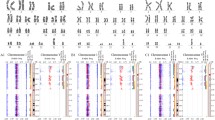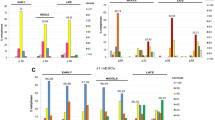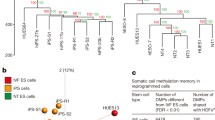Abstract
Induced pluripotent stem (iPS) cells have greatly provoked people’s interest due to their enormous potential of clinical applications. Increasing care is taken with the genetic safety of iPS cells. However, up to now, the chromosomal integrity of murine iPS (miPS) cells has been largely unknown. We have observed recurrent trisomy and/or Robertsonian translocation (Rb) of chromosome 14 in six out of nine independent miPS cell lines from three laboratories by G-banding, fluorescence in situ hybridization (FISH) and spectral karyotyping (SKY) analyses, while all the miPS cell lines were derived from mouse embryonic fibroblasts (MEFs) or neural precursor cells (NPCs) with a normal karyotype. The miPS cells with trisomy and/or Rb of chromosome 14 showed growth advantage over the miPS cells with a normal karyotype. We found a significantly higher frequency of Rbs in the miPS cell lines induced with c-Myc than those without c-Myc. Our findings demonstrate that miPS cell lines have the propensity for chromosomal aberrations and there is an obvious correlation between the extent of chromosomal aberrations in miPS cells and the transcriptional factors used for their reprogramming. Therefore, our study raises awareness of the need for improvements of the induction conditions of miPS cells in order to avoid the chromosomal aberrations and ensure future safe applications.





Similar content being viewed by others
Abbreviations
- ES:
-
Embryonic stem
- iPS:
-
Induced pluripotent stem
- MEFs:
-
Mouse embryonic fibroblasts
- NPCs:
-
Neural precursor cells
- Oct-4:
-
Octamer-binding transcription factor 4
- Sox2:
-
SRY (sex determining region Y)-box 2
- Klf4:
-
Kruppel-like factor 4
- c-Myc:
-
Cellular myelocytomatosis oncogene
- Rb:
-
Robertsonian translocation
- FISH:
-
Fluorescence in situ hybridization
- SKY:
-
Spectral karyotyping
References
Baker DE, Harrison NJ, Maltby E et al (2007) Adaptation to culture of human embryonic stem cells and oncogenesis in vivo. Nat Biotechnol 25:207–215
Blelloch R, Venere M, Yen J, Ramalho-Santos M (2007) Generation of induced pluripotent stem cells in the absence of drug selection. Cell Stem Cell 1:245–247
Difilippantonio MJ, Petersen S, Chen HT et al (2002) Evidence for replicative repair of DNA double-strand breaks leading to oncogenic translocation and gene amplification. J Exp Med 196:469–480
Draper JS, Smith K, Gokhale P et al (2004) Recurrent gain of chromosomes 17q and 12 in cultured human embryonic stem cells. Nat Biotechnol 22:53–54
Ema M, Mori D, Niwa H et al (2008) Kruppel-like factor 5 is essential for blastocyst development and the normal self-renewal of mouse ESCs. Cell Stem Cell 3:555–567
Gore A, Li Z, Fung HL et al (2011) Somatic coding mutations in human induced pluripotent stem cells. Nature 471:63–67
Guffei A, Lichtensztejn Z, Goncalves Dos Santos Silva A, Louis SF, Caporali A, Mai S (2007) c-Myc-dependent formation of Robertsonian translocation chromosomes in mouse cells. Neoplasia 9:578–588
Hussein SM, Batada NN, Vuoristo S et al (2011) Copy number variation and selection during reprogramming to pluripotency. Nature 471:58–62
Korenberg JR, Chen XN, Devon KL, Noya D, Oster-Granite ML, Birren BW (1999). Mouse molecular cytogenetic resource: 157 BACs link the chromosomal and genetic maps. Genome Res 9:514–523.
Laurent LC, Ulitsky I, Slavin I et al (2011) Dynamic changes in the copy number of pluripotency and cell proliferation genes in human ESCs and iPSCs during reprogramming and time in culture. Cell Stem Cell 8:106–118
Li W, Wei W, Zhu S et al (2009) Generation of rat and human induced pluripotent stem cells by combining genetic reprogramming and chemical inhibitors. Cell Stem Cell 4:16–19
Liu X, Wu H, Loring J et al (1997) Trisomy eight in ES cells is a common potential problem in gene targeting and interferes with germ line transmission. Dev Dyn 209:85–91
Liyanage M, Weaver Z, Barlow C et al (2000) Abnormal rearrangement within the alpha/delta T-cell receptor locus in lymphomas from Atm-deficient mice. Blood 96:1940–1946
Louis SF, Vermolen BJ, Garini Y et al (2005) c-Myc induces chromosomal rearrangements through telomere and chromosome remodeling in the interphase nucleus. Proc Natl Acad Sci USA 102:9613–9618
Mali P, Ye Z, Hommond HH et al (2008) Improved efficiency and pace of generating induced pluripotent stem cells from human adult and fetal fibroblasts. Stem Cells 26:1998–2005
Marion RM, Strati K, Li H et al (2009) A p53-mediated DNA damage response limits reprogramming to ensure iPS cell genomic integrity. Nature 460:1149–1153
Mayshar Y, Ben-David U, Lavon N et al (2010) Identification and classification of chromosomal aberrations in human induced pluripotent stem cells. Cell Stem Cell 7:521–531
Minina Iu M, Zhdanova NS, Shilov AG, Tolkunova EN, Liskovykh MA, Tomilin AN (2010) Chromosomal instability of in vitro cultured mouse embryonic stem cells and induced pluripotent stem cells. Tsitologiia 52:420–425
Nakagawa M, Koyanagi M, Tanabe K et al (2008) Generation of induced pluripotent stem cells without Myc from mouse and human fibroblasts. Nat Biotechnol 26:101–106
Okita K, Ichisaka T, Yamanaka S (2007) Generation of germline-competent induced pluripotent stem cells. Nature 448:313–317
Park IH, Zhao R, West JA et al (2008) Reprogramming of human somatic cells to pluripotency with defined factors. Nature 451:141–146
Pasi CE, Dereli-Oz A, Negrini S et al (2011) Genomic instability in induced stem cells. Cell Death Differ 18:745–753
Richardson C, Jasin M (2000) Frequent chromosomal translocations induced by DNA double-strand breaks. Nature 405:697–700
Rudolph C, Schlegelberger B (2009) Spectral karyotyping and fluorescence in situ hybridization of murine cells. Methods Mol Biol 506:453–466
Schreck RR, Disteche CM (2001) Chromosome banding techniques. Curr Protoc Hum Genet 4.2.1–4.2.36
Shi QH, Adler ID, Yu L, Zhang JX (1999) Detection of numerical chromosomal aberrations in epididymal sperm of mice using three-color FISH with chromosome-specific DNA probes. Yi Chuan Xue Bao 26:458–467
Shi Q, Adler ID, Zhang J, Zhang X, Shan X, Martin R (2000) Incidence of mosaic cell lines in vivo and malsegregation of chromosome 21 in lymphocytes in vitro of trisomy 21 patients: detection by fluorescence in situ hybridization on binucleated lymphocytes. Hum Genet 106:29–35
Sommer CA, Sommer AG, Longmire TA et al (2010) Excision of reprogramming transgenes improves the differentiation potential of iPS cells generated with a single excisable vector. Stem Cells 28:64–74
Sugawara A, Goto K, Sotomaru Y, Sofuni T, Ito T (2006) Current status of chromosomal abnormalities in mouse embryonic stem cell lines used in Japan. Comp Med 56:31–34
Takahashi K, Yamanaka S (2006) Induction of pluripotent stem cells from mouse embryonic and adult fibroblast cultures by defined factors. Cell 126:663–676
Vafa O, Wade M, Kern S et al (2002) c-Myc can induce DNA damage, increase reactive oxygen species, and mitigate p53 function: a mechanism for oncogene-induced genetic instability. Mol Cell 9:1031–1044
Vuga LJ, Ben-Yehudah A, Kovkarova-Naumovski E et al (2009) WNT5A is a regulator of fibroblast proliferation and resistance to apoptosis. Am J Respir Cell Mol Biol 41:583–589
Yu J, Vodyanik MA, Smuga-Otto K et al (2007) Induced pluripotent stem cell lines derived from human somatic cells. Science 318:1917–1920
Zha S, Bassing CH, Sanda T et al (2010) ATM-deficient thymic lymphoma is associated with aberrant tcrd rearrangement and gene amplification. J Exp Med 207:1369–1380
Acknowledgements
This work was supported by the National Natural Science Foundation of China (30711120571, 30725013 and 30671168), the National Basic Research Program (2007CB947401) of China (973) and the Deutsche Forschungsgemeinschaft (DFG, German Research Foundation) for the Cluster of Excellence REBIRTH (From Regenerative Biology to Reconstructive Therapy) at Hannover Medical School. We would like to thank Professor Julang Li (University of Guelph) for helpful discussions, Professor Guoliang Xu, Ying Jin and Jinsong Li (Shanghai Institutes for Biological Sciences, Chinese Academy of Sciences) for providing mouse-induced pluripotent stem cell lines, and Professor Shan Zha (Princeton University) for providing BAC clones.
Author information
Authors and Affiliations
Corresponding authors
Additional information
Responsible Editor: Fengtang Yang
Qian Chen and Xiaoyun Shi equally contributed to this study.
Electronic supplementary material
Below is the link to the electronic supplementary material.
Fig. S1
Pluripotency of murine iPS cells. a Examples of iPS cells that maintain characteristic mESC-colony morphology and express pluripotency markers Oct4, Nanog, Sox2 and SSEA1. b Hematoxylin and eosin staining of teratoma derived from iPS3 (upper lane) and iPS6 cells (lower lane); scale bar is 50 μm (JPEG 47 kb)
Fig. S2
The quality of SKY is evaluated by using the classified images. Representative SKY images of miPS cells showing a 41, XY, +14 (iPS2), and b 40, XY, +14, Rb(14.14) (iPS5). Each chromosome is shown in spectral image (left), inverted DAPI (middle), and after classification (right) (JPEG 38 kb)
Rights and permissions
About this article
Cite this article
Chen, Q., Shi, X., Rudolph, C. et al. Recurrent trisomy and Robertsonian translocation of chromosome 14 in murine iPS cell lines. Chromosome Res 19, 857–868 (2011). https://doi.org/10.1007/s10577-011-9239-y
Received:
Revised:
Accepted:
Published:
Issue Date:
DOI: https://doi.org/10.1007/s10577-011-9239-y




